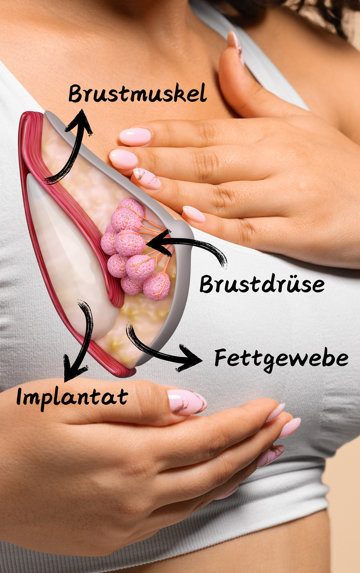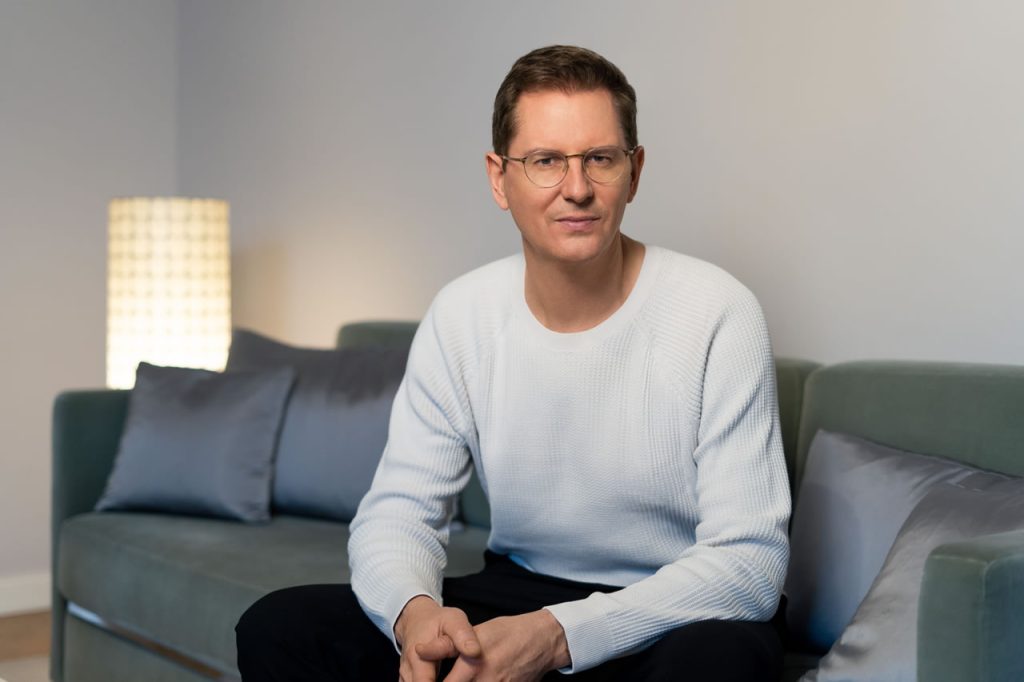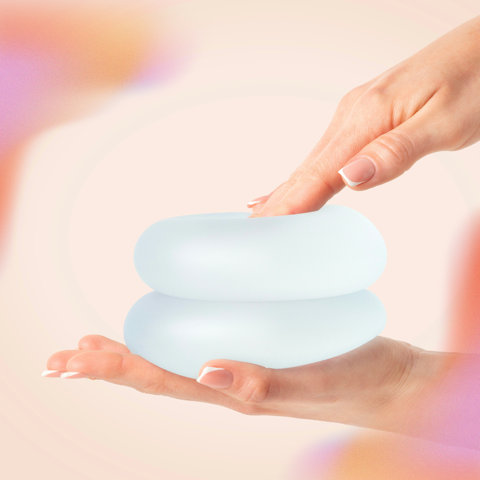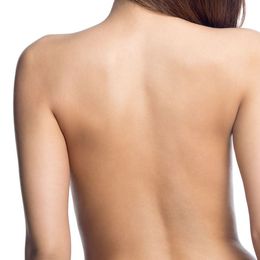Is the ability to breastfeed impaired after breast augmentation?
Depending on the method used, the ability to breastfeed is retained in most cases.
Breast augmentation allows you to express your personality and self-confidence. Nevertheless, it needs to be carefully considered. Dr Niklas Noack, an experienced specialist in plastic and aesthetic surgery, offers personal consultation and state-of-the-art methods for breast augmentation with implants at his renowned practice in Berlin. You can rely on sound expertise, individually tailored treatment and a result that looks natural and harmonious.
Welcome to our information page on upper arm lift surgery in Berlin. Here you will find all the relevant information about upper arm lift surgery to help you make an informed decision. Our aim is to give you a detailed overview of the procedure, the different methods, costs and financing options as well as the procedure for an upper arm lift.
The most important facts in brief:
| Technical term | Breast augmentation |
|---|---|
| Goal | Volume augmentation, optimisation of breast shape and firmness |
| Method | Insertion of a silicone implant under the breast |
| Duration of the operation | approx. 1.5-2 hours |
| Anaesthesia | General anaesthesia |
| Hospitalisation | 1-2 days, also outpatient if necessary |
| After the operation | Removal of drainage tubes (if inserted) and dressing change after one day, showering possible after 3 days, light Restriction of movement in the arms |
| Pain | Moderate to moderate wound pain in the first few days; Feeling of tension for 4 - 6 weeks; |
| Follow-up treatment and behavioural recommendations | Regular wound checks (2 to 3 follow-up checks), Suture removal after 2 weeks, Special brace and bra for 4 to 6 weeks day and night, Sauna and gradual increase in sporting activities after 6-8 weeks, Solarium and/or sun exposure of the seam after 1 year or earlier, but then application of sun protection factor 50 |
| Scars | Generally not very visible after healing (depending on the method) |
| Social and labour skills | After 7 to 10 days |
| Durability | approx. 15-25 years |
| Risks | General operational risks; special risks: Tissue hardening (capsular fibrosis), Sensory disturbances, Asymmetries, Slipping of the implants, Restricted ability to breastfeed (in the case of an incision on the nipple), Breast Implant Illness (BII), BIA-ALCL |
| Side effects | Tension pain (depending on implant size), Swelling, bruising; Rarely: Foreign body sensation |
Breast augmentation, medically known as breast augmentation, is a cosmetic procedure to change the size, shape and volume of the breast. It aims to harmonise the proportions of the body, it can boost self-confidence and fulfil individual expectations in terms of breast aesthetics. This procedure is extremely versatile, as it can compensate for genetic imbalances as well as changes caused by pregnancy, breastfeeding or weight loss. The results are individualised and are always based on the patient's wishes and conditions.
Breast augmentation with implants is ideal for women who are unhappy with the natural volume of their breasts or want symmetrical adjustments. Common reasons for wanting a breast augmentation include genetically small breasts, changes after breastfeeding or loss of volume due to age and weight. The decision is always individual and should focus on personal well-being.
Breast augmentation with implants is one of the most effective methods for customising the volume, shape and symmetry of the breasts. There are different access routes for the procedure. The most common method is the incision in the breast fold (inframammary, underbust fold), which offers optimal access for modelling the breast and is barely visible later on. Another approach is via the areola (periareolar), which can be particularly advantageous for small breasts or specific anatomical conditions. Alternatively, implants can be inserted through the armpit (axillary), but this method is not recommended by Dr Noack.
Depending on the patient's anatomical requirements and wishes, either round or anatomically shaped (teardrop-shaped) implants are used. Round implants are particularly suitable if a visible push effect is desired, while anatomical implants can reproduce a natural breast shape. However, this cannot be generalised: a round implant does not always look unnatural, nor does a teardrop-shaped implant always look natural. The individual case decides. For additional comfort and a natural feel, the implants are usually made of cohesive silicone gel, which is particularly safe to use.
More info about B-Lite® implants
The implants can be placed either behind the pectoral muscle (subpectoral) or in front of the pectoral muscle (epipectoral).
Subpectoral placement is often the preferred option as it provides better coverage of the implant, especially with a small initial breast, and ensures a very natural appearance.
This method has also been proven to reduce the risk of capsular fibrosis. For selected cases, Dr Noack also offers the so-called complete submuscular breast augmentation, in which not only the large pectoral muscle but also other muscles are lifted. This serves in particular to stabilise the lower pole of the breast.
For certain patient anatomies or correspondingly desired results, placement in front of the muscle can also be useful in order to achieve a good breast contour.

The first step in breast augmentation with implants is a detailed consultation. During this consultation, all aspects of the procedure, the incision, the choice of implants and their positioning as well as possible risks are discussed. Before the procedure, it is strongly recommended that you stop taking certain medications and reduce the consumption of nicotine and alcohol in order to optimise the healing process.
Before the operation, the initial findings, i.e. the current condition of the breast, are photodocumented. During the operation, which is performed under general anaesthetic, the implant is inserted either through an incision in the breast crease or in the nipple area. The choice of access route depends on your individual needs, requirements and wishes. The procedure usually takes between one and two hours.
For breast augmentation with implants, Dr Noack focuses on "rapid recovery", i.e. recovering as quickly as possible after the operation. After the operation, we recommend staying in the clinic for one night to ensure complete aftercare. In some cases, outpatient treatment is also possible. In the operating theatre, you will be given a support bra and a stabilisation belt ("Stuttgart belt") for the correct implant position, which should be worn for around 4-6 weeks. The stitches are usually removed after ten to twelve days. During the first few weeks, you should take it easy physically, sleep mainly on your back or slightly sideways and avoid sport or heavy activities. Sauna and solarium visits as well as direct sun exposure are possible again after about two to three months. Regular follow-up checks help to secure the result in the long term and recognise possible complications at an early stage.
The costs vary depending on the chosen method, the type of implants and the individual scope of treatment. For greater planning certainty, Dr Noack will provide you with a precise cost breakdown during the consultation, depending on the findings.

AUSGEZEICHNETTrustindex überprüft, ob die Originalquelle der Bewertung Google ist. Dr. Noack ist ein fachlich kompetenter, freundlicher und empathischer Arzt. Er nimmt sich Zeit und erklärt Fragen detailliert und verständlich. Ich fühle mich jedes Mal nett empfangen - sowohl von der Assistentin vorne am Empfang, als auch von Herrn Dr. Noack. Merci 💚Gepostet aufTrustindex überprüft, ob die Originalquelle der Bewertung Google ist. Ich danke Herrn Dr. Noack und dem gesamten Team in der Praxis sowie auch das Team in der Tagesklinik. Ich hatte nach meinem Autounfall defekte Implantate und war bei meinem vorigen Arzt auf mich alleine gestellt. Nach Infektionen und mehreren Implantatwechseln war ich als Laie völlig überfordert und fertig. Dann traf ich Herrn Dr. Noack und fühlte mich sofort wohl. Er hatte eine medizinische Expertise die mir als Patienten einfach die Entscheidung abgenommen hat. Ich bin begeistert gewesen und habe seinen Rat angenommen und dann habe ich auch meine nächste OP bei ihm machen lassen. Jetzt 8 Monate nach der OP ist alles verheilt. Die Implantate sind der Wahnsinn (weich und so natürlich) und er hat wirklich viel gerettet. Danke danke 🙏 endlich kann ich diese schweren Jahre vergessen.Gepostet aufTrustindex überprüft, ob die Originalquelle der Bewertung Google ist. Ich habe mich bei Dr.Noack] von Anfang an in den besten Händen gefühlt. Die Beratung war äußerst professionell, ehrlich und einfühlsam. Alle meine Fragen wurden ausführlich beantwortet, und ich hatte zu jedem Zeitpunkt das Gefühl, ernst genommen zu werden. Der Eingriff (Oberlidstraffung und Gliding-Brow-Lift) selbst verlief reibungslos und das Ergebnis hat meine Erwartungen sogar übertroffen – natürlich, ästhetisch und genau so, wie ich es mir gewünscht habe. Auch die Nachsorge war hervorragend organisiert. Das gesamte Praxisteam ist sehr freundlich, kompetent und sorgt für eine angenehme Atmosphäre. Ich bin sehr dankbar für das tolle Ergebnis und kann Dr.Noack und sein Team uneingeschränkt weiterempfehlen. (J. Carlitscheck)Gepostet aufTrustindex überprüft, ob die Originalquelle der Bewertung Google ist. Bei mir wurde ein Facelift gemacht und ich sehe absolut natürlich aus. Das war mir sehr wichtig und Dr. Noack hat das perfekt umgesetzt. Alle Fragen wurden verständlich und ausführlich besprochen. Es herrschte stets eine ruhige und gelassene Atmosphäre, die meine Aufregung gut lindern konnte. Ich habe mich vor und besonders nach dem Eingriff medizinisch und menschlich gut betreut gefühlt. Und wie vorhergesagt, hatte ich wirklich keine Schmerzen! Das alles schafft Vertrauen, so dass ich bei Bedarf wiederkommen werde.Gepostet aufTrustindex überprüft, ob die Originalquelle der Bewertung Google ist. Ich gehe schon einige Zeit zu Dr. Noack zur Lippenunterspritzung und hatte jetzt den ersten chirurgischen Eingriff (Oberlidstraffung). Ich bin mit den Beratungen und den Eingriffen immer sehr zufrieden. Es kann sein, dass man trotz Termin etwas warten muss, weil er sich für jeden Patienten die Zeit nimmt, die der Patient benötigt und das ist etwas, was ich sehr an ihm schätze. Ich kann all meine Fragen stellen und werde ausführlich beraten. Ich schätze seine ruhige, freundliche und kompetente Art und kann ihn als plastischen Chirurgen des Vertrauens nur empfehlen.Gepostet aufTrustindex überprüft, ob die Originalquelle der Bewertung Google ist. Herr Dr.Noack ist ein sehr freundlicher, empathischer Arzt mit großer fachlicher Kompetenz. Er nimmt sich Zeit und geht geduldig auf alle Fragen ein. Schon beim Betreten der wunderschönen Räumlichkeiten verspürt man direkt eine entspannte Atmosphäre. Ein großes Dankeschön auch an die nette Dame im Empfangsbereich. Durch das Gespräch mit ihr, war meine Aufregung direkt verflogen. Vielen Dank für diese tolle Erfahrung.Gepostet aufTrustindex überprüft, ob die Originalquelle der Bewertung Google ist. Beste Praxis, bester Mann.Gepostet aufTrustindex überprüft, ob die Originalquelle der Bewertung Google ist. I am very happy how Dr. Noack takes the time to give me consultation about the treatments I actually need. I appreciate his honesty in recommending only what’s necessary relevant to my skin concerns.Gepostet aufTrustindex überprüft, ob die Originalquelle der Bewertung Google ist. Ich kann Dr. Niklas Noack und sein Team wirklich nur von Herzen empfehlen! Ich habe sehr lange mit mir gehadert, ob ich eine Mastektomie und Bauchdeckenstraffung machen lassen soll. Jetzt, wo es hinter mir liegt, bin ich so unglaublich froh über diese Entscheidung – und vor allem, dass ich sie bei Dr. Noack getroffen habe. Von Anfang an habe ich mich bei ihm und seinem Team total gut aufgehoben gefühlt. Obwohl ich ein Panikpatient bin und besonders Angst vor der Narkose hatte, wurde auf all meine Sorgen und Ängste so liebevoll und einfühlsam eingegangen wie noch nie. Das Ergebnis ist einfach der Wahnsinn: Es passt perfekt zu meinem Körper, sieht richtig toll aus, und ich fühle mich endlich wieder richtig wohl in meiner Haut. Aber es ist nicht nur das Äußerliche – ich hatte kaum Schmerzen und bin jetzt, keine zwei Monate nach der OP, schon wieder so fit, dass ich langsam mit dem Sport anfangen kann. Das liegt natürlich einerseits an meinem Körper, aber ganz klar auch an den modernen Techniken und der hervorragenden Arbeit von Dr. Noack. Ich hatte schon einige OPs, die ich machen musste, und ehrlich gesagt war das bisher nie eine angenehme Erfahrung. Aber bei Dr. Noack war das komplett anders – ich habe mich noch nie so gut beraten, betreut und verstanden gefühlt wie hier. Wer überlegt, so eine OP machen zu lassen, sollte sich unbedingt vorher gut informieren – und ich kann nur sagen: Für mich war Dr. Noack die beste Entscheidung überhaupt. 🌟 Ein riesengroßes Dankeschön an Dr. Noack und sein Team – ihr seid einfach großartig! 🙏Gepostet aufTrustindex überprüft, ob die Originalquelle der Bewertung Google ist. Ich möchte an dieser Stelle ein dickes Kompliment der Sprechstundenhilfe von Dr. Noack aussprechen! Top! Nun es spricht nichts gegen die Individualität betonende kleine Korrekturen oder auch die Harmonisierung des äußeren Erscheinungsbildes. Aber es hilft, wenn jemand uns auch die gesunden Grenzen setzt! Nach meinem letzten Besuch der Praxis sagte die Arzthelferin mir in einer ziemlich sanften Art, dass ich es langsam angehen möchte. Vielen Dank für die Ehrlichkeit und die Wertschätzung! Das weiss ich sehr zu schätzen! Die Praxis ist sehr schön gestaltet!Verifiziert von: TrustindexDas verifizierte Trustindex-Abzeichen ist das universelle Symbol des Vertrauens. Nur die besten Unternehmen können das verifizierte Abzeichen erhalten, die eine Bewertungsnote über 4.5 haben, basierend auf Kundenbewertungen der letzten 12 Monate. Mehr erfahren
Even with high quality and state-of-the-art methods, there are general risks that should be taken into account when undergoing breast augmentation with implants. These include swelling, slight scarring or temporary loss of sensation in the nipple area. Serious complications such as capsular fibrosis or implant displacement rarely occur, but may require repeat treatment in the long term. Breast Implant Illness (BII) and BIA-ALCL, a systemic lymphoma disease, are also extremely rare. Dr Noack explains these risks in detail.
As implants partially cover the breast tissue, this can make mammography more difficult. However, modern placement techniques and alternative examination methods such as ultrasound significantly reduce potential risks in the early detection of cancer. Scientific studies also show no connection between breast implants and an increased risk of breast cancer.
Immediately after the operation, you may experience a feeling of tension or slight muscle soreness in the breast area, but this normally subsides quickly. Occasional swelling or haematomas disappear completely after a few weeks. Regular use of scar care products supports healing and also reduces visible scars.
Even though breast augmentation is considered a safe procedure today, risks such as capsular fibrosis, altered scarring or sensitivity disorders can occur. However, thanks to modern procedures and Dr Noack's extensive experience, these risks are reduced to a minimum.
Most branded implants are considered safe today. It is important that implants authorised in Europe are used. These can be recognised by the CE marking combined with a four-digit numerical code. The most commonly used implants are filled with a cohesive, i.e. viscous, "cross-linked" silicone gel. All implants consist of a silicone shell, only the filling varies between silicone gel or saline solution.

The costs vary depending on the chosen method, the type of implants and the individual scope of treatment. For greater planning certainty, Dr Noack will provide you with a precise cost breakdown during the consultation, depending on the findings.
If you do not want to bear the costs all at once, our practice offers various financing options, e.g. through instalment payments, to make the procedure more accessible to you.
Depending on the method used, the ability to breastfeed is retained in most cases.
Most activities can be slowly resumed after two weeks, but intensive sport can only be resumed after six weeks.
The choice of implant is made individually during the consultation, taking into account your anatomical requirements.
After breast augmentation, muscle tension or hardened scars may occur in the breast area. This is often part of the natural healing process.
What you can do:
The choice of implant depends on your individual wishes and anatomical requirements.
Important factors:
There are two main types of implants:
Differences in form:
In the first few weeks after the operation, differences in the height or shape of the breasts are common.
Why is this happening?
When should you act?
Sport is temporarily restricted after breast augmentation.
Consult your doctor before resuming sporting activities, especially if they involve exercises with a high chest load.
After breast augmentation, you may experience feelings of tension or pain, especially if the implant is placed under the pectoral muscle.
Pain relief:
A special compression bra is recommended after the operation to support healing.
During pregnancy, hormonal changes can affect the shape of the breast, regardless of whether implants are present.
Possible effects:
Over the years, the skin and tissue can change while the implants retain their shape.
Possible changes:
Yes, breast augmentation can offer a very natural result with the right planning.
Important for natural results:
Saline implants are less popular because they:
Yes, breast augmentation and breast lift can be combined in one procedure.
Advantages of the combination:
Capsular fibrosis is a hardening of the tissue around the implant.
Causes:
Symptoms:
Treatment:
Implants can make mammography slightly more difficult, but modern examination methods compensate for this.
Dr Noack will give you comprehensive advice on how you can optimise your preventive care after breast augmentation.
Get personalised and comprehensive advice. Make an appointment with Dr Niklas Noack today and fulfil your wish for a breast augmentation that suits you. Place your trust in quality, expertise and empathetic care.
Click on the "Arrange a consultation appointment now" button to go directly to our online booking system.
Our practice is located in:
Alte Schönhauser Straße 23
10119 Berlin
Our opening hours are from Monday to Friday from 10:00 to 17:00.

I look forward to hearing from you.